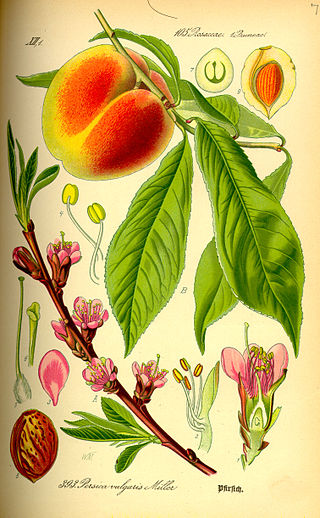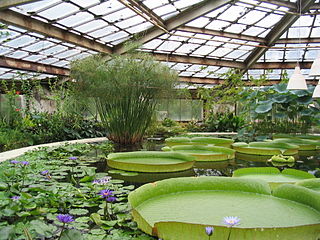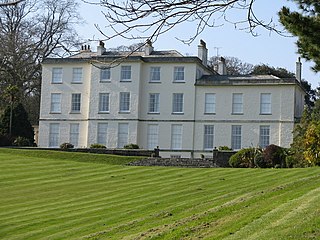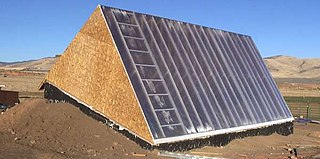
The peach is a deciduous tree first domesticated and cultivated in Zhejiang province of Eastern China. It bears edible juicy fruits with various characteristics, most called peaches and others, nectarines.

The pineapple is a tropical plant with an edible fruit; it is the most economically significant plant in the family Bromeliaceae.

The Lost Gardens of Heligan are located near Mevagissey in Cornwall, England and are considered to be amongst the most popular in the UK. The gardens are typical of the 19th century Gardenesque style with areas of different character and in different design styles.

A greenhouse is a special structure that is designed to regulate the temperature and humidity of the environment inside. There are different types of greenhouses, but they all have large areas covered with transparent materials that capture sunlight and heat. The most common materials used in modern greenhouses for walls and roofs are rigid plastic made of polycarbonate, plastic film made of polyethylene, or glass panes. When the inside of a greenhouse is exposed to sunlight, the temperature increases, providing a sheltered environment for plants to grow even in cold weather.

Horticulture is the science, technology, art, and business of cultivating and using plants to improve human life. Horticulturists and Horticultural Scientists create global solutions for safe, sustainable, nutritious food and healthy, restorative, and beautiful environments. This definition is seen in its etymology, which is derived from the Latin words hortus, which means "garden" and cultura which means "to cultivate". There are various divisions of horticulture because plants are grown for a variety of purposes. These divisions include, but are not limited to: gardening, plant production/propagation, arboriculture, landscaping, floriculture and turf maintenance. For each of these, there are various professions, aspects, tools used and associated challenges; Each requiring highly specialized skills and knowledge of the horticulturist.

Feijoa sellowiana also known as Acca sellowiana (O.Berg) Burret, is a species of flowering plant in the myrtle family, Myrtaceae. It is native to the highlands of southern Brazil, eastern Paraguay, Uruguay, and northern Argentina. Feijoa are also common in gardens of New Zealand. It is widely cultivated as an ornamental tree and for its fruit. Common names include feijoa, pineapple guava and guavasteen, although it is not a true guava. It is an evergreen shrub or small tree, 1–7 metres (3.3–23.0 ft) in height.

The loquat is a large evergreen shrub or tree grown commercially for its orange fruit and for its leaves, which are used to make herbal tea. It is also cultivated as an ornamental plant.

Monstera deliciosa, the Swiss cheese plant or split-leaf philodendron is a species of flowering plant native to tropical forests of southern Mexico, south to Panama. It has been introduced to many tropical areas, and has become a mildly invasive species in Hawaii, Seychelles, Ascension Island and the Society Islands. It is very widely grown in temperate zones as a houseplant.

A polytunnel is a tunnel typically made from steel and covered in polyethylene, usually semi-circular, square or elongated in shape. The interior heats up because incoming solar radiation from the sun warms plants, soil, and other things inside the building faster than heat can escape the structure. Air warmed by the heat from hot interior surfaces is retained in the building by the roof and wall. Temperature, humidity and ventilation can be controlled by equipment fixed in the polytunnel or by manual opening and closing of vents. Polytunnels are mainly used in temperate regions in similar ways to glass greenhouses and row covers. Besides the passive solar heating that every polytunnel provides, every variation of auxiliary heating is represented in current practice. The nesting of row covers and low tunnels inside high tunnels is also common.

Grevillea, commonly known as spider flowers, is a genus of about 360 species of evergreen flowering plants in the family Proteaceae. Plants in the genus Grevillea are shrubs, rarely trees, with the leaves arranged alternately along the branches, the flowers zygomorphic, arranged in racemes at the ends of branchlets, and the fruit a follicle that splits down one side only, releasing one or two seeds.

A walled garden is a garden enclosed by high walls, especially when this is done for horticultural rather than security purposes, although originally all gardens may have been enclosed for protection from animal or human intruders. In temperate climates, especially colder areas, such as Scotland, the essential function of the walling of a garden is to shelter the garden from wind and frost, though it may also serve a decorative purpose. Kitchen gardens were very often walled, which segregated them socially, allowing the gardeners, who were usually expected to vanish from the "pleasure gardens" when the occupants of the house were likely to be about, to continue their work. The walls, which were sometimes heated, also carried fruit trees trained as espaliers.

Thomas Andrew Knight (1759–1838), FRS, of Elton Hall in the parish of Elton in Herefordshire and later of Downton Castle, was a British horticulturalist and botanist. He served as the 2nd President of the Royal Horticultural Society (1811–1838).

The Dunmore Pineapple is a folly in Dunmore Park, near Airth in Stirlingshire, Scotland. In 1995 it was ranked "as the most bizarre building in Scotland".

Phoenix canariensis, the Canary Island date palm or pineapple palm, is a species of flowering plant in the palm family Arecaceae, native to the Canary Islands off the coast of Northwestern Africa. It is a relative of Phoenix dactylifera, the true date palm. It is the natural symbol of the Canary Islands, together with the canary Serinus canaria. Mature P. canariensis are often used in ornamental landscaping and are collected and transplanted to their new planting location. A Canary Island date palm with 10 m (30 ft) of trunk is about 60 years of age.

The Heligan estate was the ancestral home of the Tremayne family near Mevagissey in Cornwall, England. Purchased by Sampson Tremayne in 1569, the present house was built in 1692 and extended in the early 19th century. The family left the house after World War I, and by the end of World War II the house and gardens had fallen into disrepair. The house and outbuilding were converted into flats in the 1970s and the garden was considered lost, but it was rescued during a televised project in 1996. The Lost Gardens of Heligan are now open to the public as a tourist attraction.

The Potager du roi, near the Palace of Versailles, produced fresh vegetables and fruits for the table of the court of Louis XIV. It was created between 1678 and 1683 by Jean-Baptiste de La Quintinie, the director of the royal fruit and vegetable gardens. Today it is run by the École nationale supérieure du paysage, the grande école for landscape architects. It is officially recognized as a Remarkable Garden of France.

The fig is the edible fruit of Ficus carica, a species of small tree in the flowering plant family Moraceae, native to the Mediterranean region, together with western and southern Asia. It has been cultivated since ancient times and is now widely grown throughout the world. Ficus carica is the type species of the genus Ficus, containing over 800 tropical and subtropical plant species.

A walipini is an earth-sheltered cold frame. It derives its name from the Aymaran languages. It is similar in concept to the pineapple pit that was used, as the name implies, to cultivate pineapple and other exotic fruits in Victorian era Britain and in the cold plains of pre-revolution Russia.
Forcing is the horticultural practice of bringing a cultivated plant into active growth outside of its natural growing season. Plants do not produce new growth or flowers during the winter, and many species only produce flowers or fruit for a very limited period. Forcing allows horticulturalists to produce these flowers and fruits at other times. This can be accomplished by cultural, physical, or chemical means, and is typically done to produce out-of-season flowers or fruit for display, consumption or sale. Forcing allows the more predictable production of products for sale, and can improve the quality of the products in some cases.
Pineapple mania, also known as pineapple fever, was approximately a 150-year period from the early 18th century to the mid to late 19th century when European royalty and horticulturists were obsessed with cultivating pineapple due to its novel introduction from the New World and its legendary status as a symbol of the perfect fruit. The difficulty of growing pineapples in a cold climate contributed to its scarcity and its inordinate expense, making it an elite, luxury fruit and an acknowledged symbol of great wealth, power, and status. Unlike most fruits known at the time that had a large body of knowledge and literature stretching back to antiquity, the unknown nature of the pineapple gave rise to imaginative flights of fantasy that quickly took root in popular culture. This new perception would later influence cuisine, the decorative arts, architecture, philosophy, and technology throughout Europe and the newly formed United States.


















